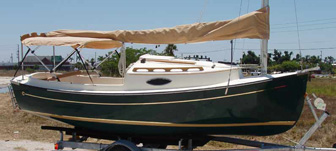 The Sun Cat is a delight to launch and rig — plus easy to sail, and comfortable, too!
The Sun Cat is a delight to launch and rig — plus easy to sail, and comfortable, too!
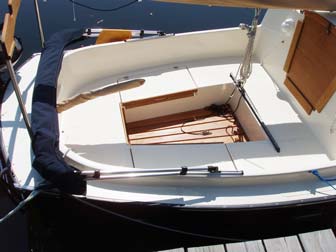
The cockpit in the Sun Cat is surprisingly roomy for a small sailboat.
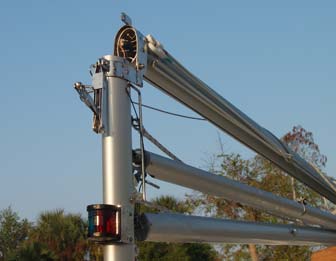
The hinged mast makes it easy and fast to rig — The Sun Cat's main boom, gaff boom, and rigging lines stay in place while the mast is raised and lowered.
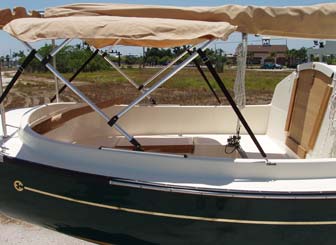
I recommend buying the Sun Cat's optional bimini top if you live in a warm climate.
I got another chance last week to sail on a 17' Com-Pac Sun Cat, and it is one of very few trailerable sailboats that is a delight from beginning to end. We got to the boat ramp, and it took me less time to untie the rigging and raise the mast than it took for two other guys to get the outboard engine out of the truck and hang it on the adjustable motor bracket. In just a few minutes, we were ready to back down the ramp.
Com-Pac's exclusive Mastendr (tm) system consists of a mast with a stainless steel hinge a couple of feet above the deck and a quick rig tensioning Highfield lever on the forestay. Just lift the mast to vertical (it is very lightweight) and insert the safety pin in the hinge to hold it, pin the forestay in place, swing the lever to tighten the rig and secure it with another pin, and the boat is ready to sail.
The main boom, gaff boom, sail, and all running rigging remain in place when trailering, so rigging time is cut dramatically compared to most trailerable sailboats.
Lowering the Mast While Afloat — It's Easy On a Sun Cat
We motored out the channel and raised the sail, only to find that the main halyard was improperly led through the cheek block at the top of the mast, and we could not get it all the way up. This was a new boat, and Com-Pac very seldom makes such an error in rigging, but someone messed up in this case. On many trailerable sailboats, the discovery would have meant a trip back to the ramp to set the boat back on the trailer in order to fix the problem, but not on a Sun Cat. I went forward, released and lowered the mast, and re-threaded the halyard properly, and we were raising the mainsail back up a few minutes later.
The sail is raised by simultaneously pulling on the main (or throat) halyard and the peak halyard, lifting the gaff boom in a more or less horizontal attitude until the throat halyard is all the way up against the block, then the peak halyard is raised the rest of the way, pulling the top of the sail up above the top of the mast. Because of the 2:1 purchase on the peak halyard, the easiest way to accomplish this is to pull both halyards, then pull only the peak halyard, repeating until the throat halyard is all the way up. Both are led through Spinlock line clutches, so you can release them momentarily without losing any ground.
The line clutches are a neat design — you snap the line upward to tilt and release them, and snap it back downward to engage the locking cam. Another identical one is used on the port side coachroof for the downhaul.
The Sun Cat's Trim Adjustments
For such a simple little boat, the Sun Cat has quite a few trim adjustment capabilities. Sloop sailors will have to get used to the fact that one of the halyards is actually a sail trim adjustment. The peak halyard controls the angle of the gaff boom, and small adjustments make a big difference in sail shape and performance. The downhaul controls tension along the luff, and is used in the same way as it would be used on a sloop rig.
There are two outhauls, one for each boom, and those can be used to flatten the sail or make it more full, depending on conditions. The boat has a traveler mounted across the bridgedeck, enabling good control over sail shape and main boom position on all points of sail. Last but not least, the stainless steel centerboard affects helm balance and thus is yet another trim adjustment. Update: see the rigging modifications I did on our Sun Cat.
The Sun Cat's Performance Upwind
Upwind, the boat likes all controls except the mainsheet set fairly tight and the centerboard all the way down. A common error made by sloop sailors is to pull the main boom over the center of the boat, which will result in lousy performance. On a catboat, you set the mainsail to about the same angle you would use for a jib on a sloop. No one pulls a jib flat and tight over the center of the boat to beat upwind, and you should not do that to a cat rig either. The boom end should be near the corner of the boom gallows for best performance when beating to windward. Pulling it closer to the centerline will not allow you to point higher.
We did a few tacks upwind, and the boat performs well with proper trim. Because of the wide beam and ballasted shoal keel, heeling angles on an upwind beat are comfortably low. The Sun Cat really punishes those with a tendency to pinch, but if you let the cat rig fill up and maintain proper air flow, it has plenty of power to move the boat upwind and get through tacks without much speed loss.
Reaching
On a reach, the boat likes a slightly eased peak halyard, and by slightly I mean an inch or maybe two. Small adjustments make a big difference in sail shape, and it is easy to go too far. Once again the angle of the sail should be similar to the angle used for a jib, not a main, on a sloop. A good catboat rule of thumb, especially for beginners, is "when in doubt, let it out." The boat will have a bit of weather helm on a reach, but pulling up the centerboard a bit will balance it.
The Sun Cat is quite responsive to small adjustments, and will quickly let you know what it likes and what it does not like. We soon had the boat reaching across the harbor at a good clip, the centerboard pendant humming a happy tune.
Running Downwind
The hardest part about sailing a Sun Cat is making the decision to go home, but the time came to head in, and we turned downwind toward our destination. This is the part of catboat sailing that sloop sailors will like the best. No more blanketed jib flapping around uselessly, no more need to rig a whisker pole on one side and a preventer on the other for a wing on wing run, you just let the traveler down and let the mainsheet all the way out, and all that sail area goes to work.
On a run, the centerboard should be pulled all the way up to reduce drag. The boat tracks well without it, and leaving it down can make the boat round up excessively in the event of an accidental jibe.
Cockpit Comfort, and Going Home
The curved aft corners of the Sun Cat cockpit wrap around the helmsman's shoulders and it feels like the boat is giving you a nice hug as you lean back and relax in the corner. The three of us were all able to find comfortable spots in the shade of the Bimini top, a necessity on a warm day while running with the wind.
We lowered the engine and fired it up to turn upwind and drop the sail. Many owners outfit the Sun Cat with lazy jacks, which help to contain the sail as it falls, and also help to control the swinging of the gaff boom as it comes down. The main boom falls into the gallows, and if the rest of the sail and the gaff boom are kept on top of it by lazy jacks, the whole procedure is quick and easy.
There is a pin which can be inserted through the mast hinge, holding the forward end of the main boom high enough above the deck to clear the bimini top and allow the forward hatch to open. If the boat is to be docked or anchored, this is very convenient. If it is going right back on a trailer and the mast is coming back down, there is no reason to pin the boom at the hinge, since the booms and sail must be below the hinge to lower the mast.
The Sun Cat is a great choice for anyone who wants a small sailboat that is both comfortable and easy to sail, and it also has enough responsiveness and trim adjustments to please and challenge even very experienced sailors. For those who intend to trailer the boat each time it is used, the Sun Cat's quick and easy Mastendr (tm) rig system makes a short afternoon sail a possibility by dramatically reducing time spent at the ramp. Many small trailerable sailboats take 20 to 30 minutes to rig, and if you only have a couple of hours to spare, going for a quick sail is just not worth it. With a Sun Cat, you can be out on the water in minutes, and be back on the road home a few minutes after arriving back at the boat ramp.
Sun Cat Is Available With or Without a Small Cabin
The boat is made in two versions. The Sun Cat Daysailer is an open boat with a huge cockpit capable of seating 6 adults with room to spare. There is abundant storage under the cockpit benches, and an enclosed locker forward providing more storage space. The standard Sun Cat has a cabin with two berths and space under the bridgedeck for a porta potti. The cabin is quite spacious for a 17' boat due to the 7'3" beam, and is great for overnight trips.
Update: Com-Pac Yachts introduced a design in between the Daysailer and the Sun Cat, called the Sunday Cat. It has a small cabin forward, just big enough for a porta potti, and a larger cockpit than the full cabin Sun Cat version. At right is a picture of a Sunday Cat competing in the 2011 Sun Cat National Championship Regatta on Charlotte Harbor.
For those who just want a simple little daysailer, Com-Pac also makes the 14' Picnic Cat, and for more ambitious cruisers they make the 20' Horizon Cat, which features wheel steering and is available with a small Yanmar diesel engine or an adjustable outboard engine mount.
All share the same Mastendr quick and easy rigging system and have very similar sailing characteristics. Any of the Com-Pac catboats would make a great choice for trailer sailors who want a comfortable boat that is very quick and easy to rig and sail.
- Com-Pac Legacy Review
- For more on Com-Pac catboats, I recommend the catboat forum at trailersailor.com.
Attention Catboat Sailors
- Catboat sailors of all kinds can download and enjoy this Catboat Sailing Manual, filled with information about catboat sailing techniques and specifics about certain Com-Pac and Marshall catboats:
Catboat Sailing Manual in pdf format
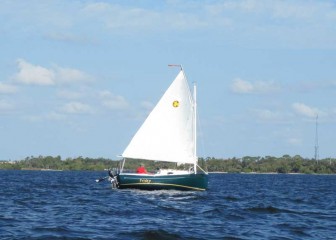
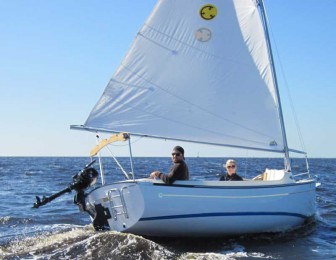
Looking to purchase a SunCat for grandchildren, all family members and wife and self. I have completed a lot of reviews and input from sales and believe the SunCat will meet our needs, I also like the Horizon Cat but twice the dollars, we are retired.